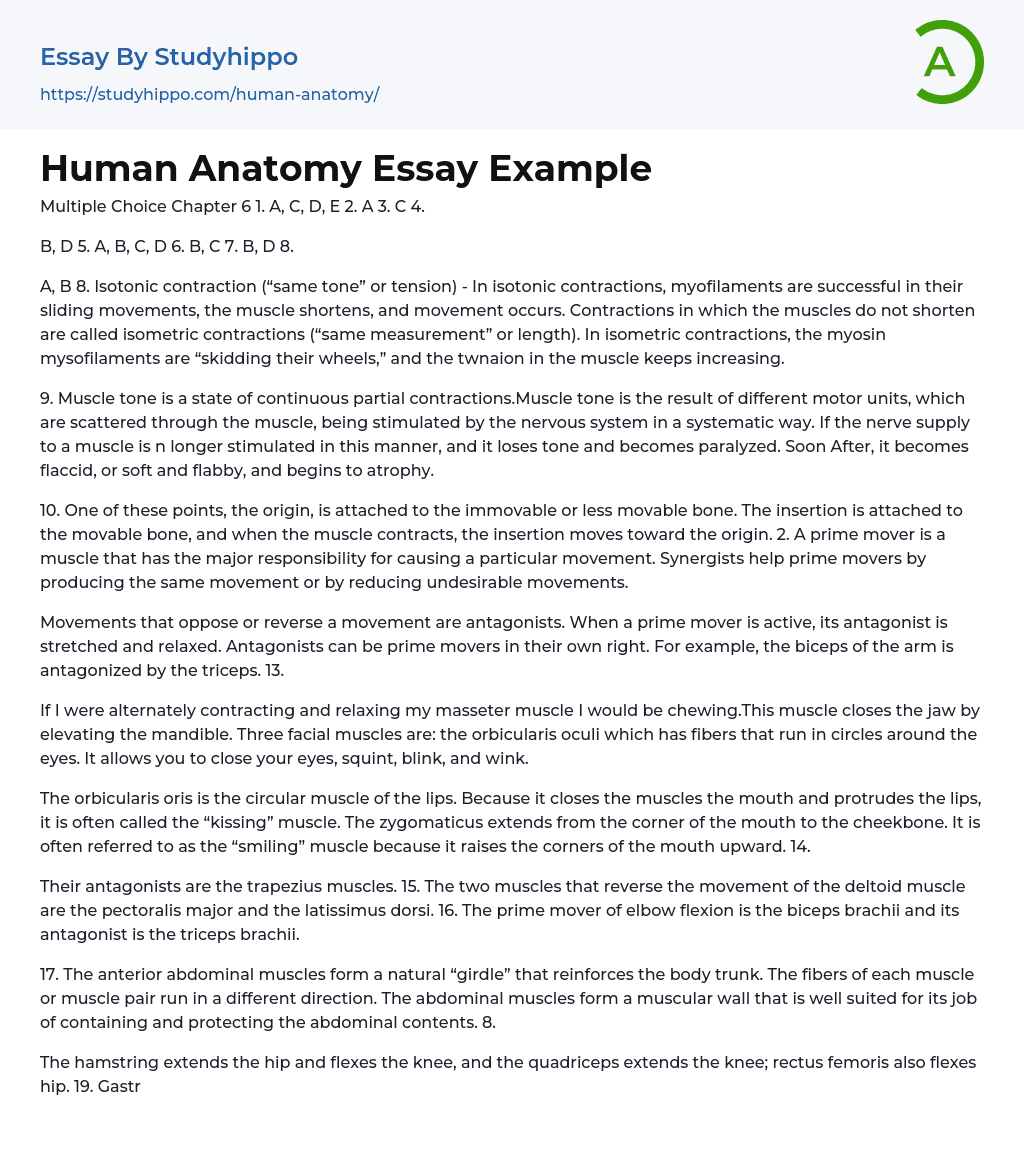Multiple Choice Chapter 6 1. A, C, D, E 2. A 3. C 4.
B, D 5. A, B, C, D 6. B, C 7. B, D 8.
A, B 8. Isotonic contraction (“same tone” or tension) - In isotonic contractions, myofilaments are successful in their sliding movements, the muscle shortens, and movement occurs. Contractions in which the muscles do not shorten are called isometric contractions (“same measurement” or length). In isometric contractions, the myosin mysofilaments are “skidding their wheels,” and the twnaion in the muscle keeps increasing.
9. Muscle tone is a state of continuous partial contractions.Muscle tone is the result of different motor units, which are scattered through the muscle, being stimulated by the nervous system in a systematic way. If the nerve supply to a muscle is n longer stimulated in this manner, and it loses tone and becomes paralyzed.
...Soon After, it becomes flaccid, or soft and flabby, and begins to atrophy.
10. One of these points, the origin, is attached to the immovable or less movable bone.
11.The insertion is attached to the movable bone, and when the muscle contracts, the insertion moves toward the origin.
12. A prime mover is a muscle that has the major responsibility for causing a particular movement. Synergists help prime movers by producing the same movement or by reducing undesirable movements.
Movements that oppose or reverse a movement are antagonists. When a prime mover is active, its antagonist is stretched and relaxed. Antagonists can be prime movers in their own right. For example, the biceps of the arm is antagonized by the triceps.
13.If I were alternately contracting and relaxing my masseter muscle I would be chewing.This muscle closes the jaw b
elevating the mandible. Three facial muscles are: the orbicularis oculi which has fibers that run in circles around the eyes. It allows you to close your eyes, squint, blink, and wink.
The orbicularis oris is the circular muscle of the lips. Because it closes the muscles the mouth and protrudes the lips, it is often called the “kissing” muscle. The zygomaticus extends from the corner of the mouth to the cheekbone. It is often referred to as the “smiling” muscle because it raises the corners of the mouth upward.
14.Their antagonists are the trapezius muscles.
15. The two muscles that reverse the movement of the deltoid muscle are the pectoralis major and the latissimus dorsi.
16. The prime mover of elbow flexion is the biceps brachii and its antagonist is the triceps brachii.
17. The anterior abdominal muscles form a natural “girdle” that reinforces the body trunk. The fibers of each muscle or muscle pair run in a different direction. The abdominal muscles form a muscular wall that is well suited for its job of containing and protecting the abdominal contents.
18.The hamstring extends the hip and flexes the knee, and the quadriceps extends the knee; rectus femoris also flexes hip.
19. Gastrocnemius is the two-bellied muscle that makes up the calf region of the leg. It plantar flexes foot and flexes the knee.
20. Muscles that are exercised regularly remain healthy.
Regular exercise increases muscle size, strength, and endurance. Muscles that are exercised vigorously they hypertrophy, and when they are not used they atrophy, which means that they lose mass and become weak.
- Emergence essays
- Anxiety Disorder essays
- Post-traumatic Stress Disorder essays
- Insanity essays
- Addiction essays
- Anatomy and Physiology essays
- Biodegradation essays
- Cancer essays
- Dental Care essays
- Disability essays
- Disease essays
- Disorders essays
- Health Care essays
- Infectious Disease essays
- Inquiry essays
- Intelligence Quotient essays
- Lung Cancer essays
- Medicine essays
- Neurology essays
- Nutrition essays
- Olfaction essays
- Physical Exercise essays
- Public Health essays
- Sex essays
- Women's Health essays
- World health organization essays
- Adhd essays
- Antisocial Personality Disorder essays
- Anxiety essays
- Bipolar Disorder essays
- Depression essays
- Depression And Anxiety essays
- Dyslexia essays
- Learning Disability essays
- Major Depressive Disorder essays
- Mental Disorder essays
- Mental Illness essays
- Psychosis essays
- Schizophrenia essays
- Stress essays
- Suicide essays
- Action Potential essays
- Blood essays
- Body essays
- Brain essays
- Childbirth essays
- Eye essays
- Glucose essays
- Heart essays
- Human Physiology essays




